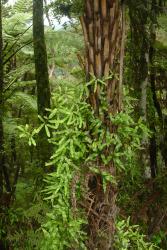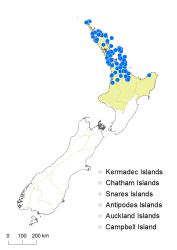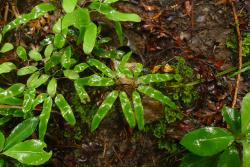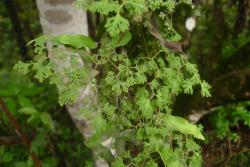- = Lygodium gracilescens Colenso, Trans. & Proc. New Zealand Inst. 28: 620 (1896)
Rhizomes long-creeping; bearing shiny, chestnut-brown, septate hairs, 1.5–3 mm long. Adult fronds of indeterminate growth, twining and climbing to tops of trees. Stipes pale brown, sparsely hairy at base. Rachises pale brown, tough and wiry. Pinnae arising alternately along rachis. Sterile and fertile pinnae, or sometimes sterile and fertile segments on one pinna, markedly dimorphic. Sterile pinnae 60–175 mm long, rarely to 220 mm long; costae branching dichotomously or pseudo-dichotomously 2–4 times, with a sterile bud and long, colourless, acicular hairs present in the axil of the first dichotomy; ultimate segments narrowly ovate or narrowly oblong, 30–120 mm long, or rarely 160 mm long, 5–20 mm wide, apices acuminate, acute or round, margins entire, bases acute to almost truncate, articulated to costae, bright green above, blue-green below, herbaceous, glabrous. Fertile pinnae 35–105 mm long; costae branching pseudo-dichotomously 5–8 times, with a sterile bud and long colourless acicular hairs present in the axil of the first dichotomy; segments ovate, broadly ovate or broader than long, 3–30 mm long, 3–22 mm wide, apices acute or obtuse, deeply dissected, bases attenuate, articulated to costae, glabrous. Veins free. Sporangia arranged on marginal lobes of the fertile segments, 2–18 per sporogenous lobe.
Lygodium articulatum is easily recognised by its twisting, climbing habit – the only fern of its type in New Zealand. It grows from a long-creeping terrestrial rhizome and produces adult climbing fronds of indeterminate length, which can develop into dense tangles. The markedly different fertile and sterile segments are also very distinctive.
North Island: Northland, Auckland, Volcanic Plateau, Gisborne, Taranaki.
Altitudinal range: 0–950 m.
Lygodium articulatum occurs from North Cape, throughout Northland and Auckland, south to the King Country, Kaimai Ranges and the eastern Bay of Plenty. It grows from near sea level, reaching about 740 m on Mt Hereheretaunga near Te Kaha, and 950 m on Mt Te Aroha.
Common as a climbing fern in mānuka and kānuka scrub, and in kauri, podocarp and broadleaved forest, in lowland and montane areas of northern New Zealand.
n = c. 70 (Brownlie 1961). This is not consistent with the base number of 29 and 30 for Lygodium given by Smith et al. (2006), and needs reassessment.







